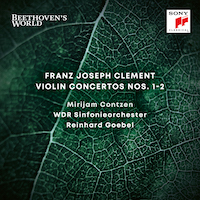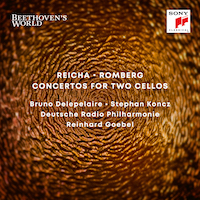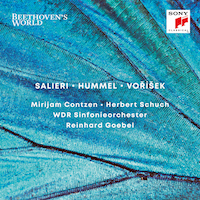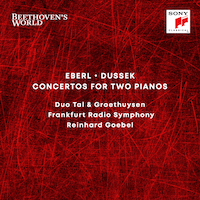Concerto Concentrations 5: “Beethoven’s World”
|
Grant Chu Covell [December 2020.]
“Beethoven’s World.” Franz Joseph CLEMENT: Concerto No. 1 in D major for Violin and Orchestra (1805); Concerto No. 2 in D minor for Violin and Orchestra (ca. 1806). Mirijam Contzen (vln), WDR Symphony Orchestra, Reinhard Goebel (cond.). Sony Classical 19075929632 (1 CD) (www.sonyclassical.de). “Beethoven’s World.” Antonín REICHA: Sinfonia Concertante in E major for Two Cellos and Orchestra (1805). Bernhard ROMBERG: Concertino for Two Cellos, Op. 72 (ca. 1840)*. Josef von EYBLER: Divertisment für Fasching Dienstag (1805)*. Stephan Koncz*, Bruno Delepelaire* (vlc), German Radio Philharmonic Orchestra Saarbrücken, Reinhard Goebel (cond.). Sony Classical 19075929652 (1 CD) (www.sonyclassical.de). “Beethoven’s World.” Antonio SALIERI: 26 Variazioni Sull’Aria “La Folia di Spagna” (1815). Johann Nepomuk HUMMEL: Double Concerto in G major for Violin, Piano and Orchestra, Op. 17 (1804). Jan Václav Hugo VOŘÍŠEK: Symphony in D major, Op. 23 (1823). Mirijam Contzen (vln), Herbert Schuch (pno), WDR Symphony Orchestra, Reinhard Goebel (cond.). Sony Classical 19075929602 (1 CD) (www.sonyclassical.de). “Beethoven’s World.” Ludwig van BEETHOVEN: Gratulations-Minuett, WoO 3 (1822). Anton EBERL: Concerto for Two Pianos and Orchestra in B-flat major, Op. 45 (1803)*. Jan Ladislav DUSSEK: Concerto for Two Pianos and Orchestra in B-flat major, Op. 63 (1806)*. Josef von EYBLER: “La Follia di Spagna” (1802). Duo Tal & Groethuysen*: Yaara Tal, Andreas Groethuysen (pno), Frankfurt Radio Symphony, Reinhard Goebel (cond.). Sony Classical 19075929592 (1 CD) (www.sonyclassical.de). Beethoven looms so large that it is difficult to see around him and fairly consider his contemporaries. These four discs give the impression that their featured composers were intending to entertain, whereas we imagine Beethoven was striving for permanence. Of course Beethoven’s eternal influence biases us as we try to be objective. Goebel’s collection centers around concertos. If we consider Beethoven’s less-familiar efforts in the genre, the Romances, Opp. 40 and 50, and the Triple Concerto, Op. 56, we still admire their materials and how they are developed. But they are nonetheless familiar, and it would take many programs and performances for Hummel, Eberl and Clement to become commonplace. It is hard to listen to these works and not set them aside for something well known. Clement, Reicha and Romberg launch into blustery expositions, requiring plenty of elbow room to maneuver their ideas. Transitions can be soggy, formal designs are completed mechanically. After these concertos finish, the feeling is frequently of relief, not commendation. The soloists rarely get the first shot at introducing a motive, and none of these composers would introduce anything as unexpected as that nudging D# which appears startingly in Beethoven’s Violin Concerto, Op. 61 (1806). These are entertaining works, especially if we are patient, and they are finely ushered forth by Goebel and his colleagues. Clement (1780-1842) appears firmly anchored in Classical patterns and harmonies. These concertos offer transitions and flourishes which align seamlessly with Mozart and Haydn’s models. Because Beethoven’s concerto was written at Clement’s insistence, and because Clement helped Beethoven with some passages, there are undoubtedly lurking relationships between Clement’s and Beethoven’s Concertos that a more sympathetic listener could tease out. Clement’s No. 2 opens with D-minor flares recalling similarly keyed Mozart concertos, but the flow of ideas and modulations is less artful. It would seem Mozart and Beethoven knew when they had a fine idea and how to run with it (which they probably learned from Haydn). However, the second and third movements are earnest and delightful. The Reicha Double Concerto spins out a lengthy introduction (the entire Allegro non troppo is 21:49), and eventually everything blurs familiarly. Two cellos make a strange combination, tending towards an amber sluggishness, especially as Reicha (1770-1836) asks the soloists to echo each other, or pair in close intervals. I wonder if the orchestra in Reicha’s day was smaller, and if Goebel’s balance leans more towards a generous Romantic scale. Romberg’s Concertino is the latest work among these four releases. With its charming flourishes and overall lightheartedness, Paganini immediately comes to mind. Perhaps these are characteristics (simple harmonies, continual opportunities for small-scale theatrics) that we ascribe after the fact when Romberg (and Paganini) were trying to be serious. Romberg (1767-1841) often provides one cello with melody and the other with an Alberti bass or rolling arpeggios, as if this were a translated keyboard item. Other pieces by Eybler (1765-1846) reveal greater gravity, for example, his String Quartets, Op. 1, or the two Symphonies. The Divertisment groups three ceremonial and pithy dances for orchestra with Turkish percussion (Entrada, Contredanza, and Allemande). Eybler’s Theme and Variations orchestrates Corelli’s Op. 5, No. 12, allowing different solo instruments to shine, including bells. Was La Folia di Spagna really so popular? It’s well delivered, but Salieri’s 26 Theme and Variations is a repetitive bucket of fluff. Perhaps we feel sorry for Salieri (1750-1825) because of that business with Mozart (whether real or invented). However, this lengthy 18-minute sequence doesn’t help. Salieri’s variations stick to their eight-bar theme. We may hear a violin flourish (or harp filigree, or brass chorale, etc.), and the next gestures will be similar and predictable. From the start, orchestra and piano propose bustling and interesting material in the Hummel Double. Hummel (1778-1837) whose primary instrument was the piano was perhaps not sympathetic to the violin which rarely gets to speak first. Perhaps it’s the balance or the instruments used, but Contzen sounds thinner than in the Clement concertos. The lively Voříšek (1791-1825) anchors this disc. Voříšek’s only Symphony straddles Classical and Romantic, leaning away from orderliness into tempestuousness in its Andante. I sense a temporal shift between the first two and last two movements. The Scherzo’s drama and flirtatiousness is nothing like the staid opening Allegro, and the Finale grows expansively. The pithy Beethoven Minuet affords a quick compare with Eberl (1765-1807) and Dussek (1760-1812), although the nearly two-decades’ stylistic difference can prejudice. These Eberl and Dussek pieces represent the Classical period whereas Beethoven’s signature orchestral tricks (doubled bass lines, contrapuntal accompaniment, etc.) lean forward. The Eberl Concerto’s Allegro won’t repay investment, but the subsequent two movements which flow operatically as theme and variations continually surprise. The Dussek Double is in a different league, intricate passagework fortified with parallel thirds and sixths. Overall, second and third movements are more spirited and lighter. Thinking back to Clement and Romberg alongside Eberl and Dussek, it’s as if sonata-allegro movements had to be stodgy and ponderous whereas central slower movements could be au courant (operatic, theme and variations, etc.) and the last movements could pleasantly explore a tune (a Rondo, something folksy, further variations, etc.). It is good to hear complete works, but middle and last movement excerpts may have made for a completely different, more lively set.
[Previous Article:
Used Bin Troll Tweets TT.]
[Next Article:
String Theory 34: Many Guitars and a Banjo]
|



